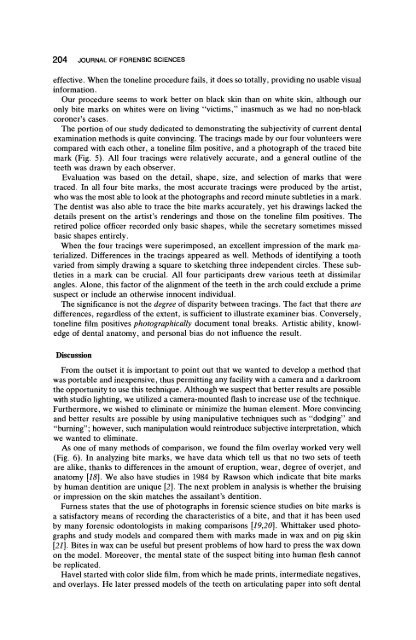Toneline Bite Mark Photography - Library
Toneline Bite Mark Photography - Library
Toneline Bite Mark Photography - Library
Create successful ePaper yourself
Turn your PDF publications into a flip-book with our unique Google optimized e-Paper software.
204 JOURNAL OF FORENSIC SCIENCES<br />
effective. When the toneline procedure fails, it does so totally, providing no usable visual<br />
information.<br />
Our procedure seems to work better on black skin than on white skin, although our<br />
only bite marks on whites were on living "victims," inasmuch as we had no non-black<br />
coroner's cases.<br />
The portion of our study dedicated to demonstrating the subjectivity of current dental<br />
examination methods is quite convincing. The tracings made by our four volunteers were<br />
compared with each other, a toneline film positive, and a photograph of the traced bite<br />
mark (Fig. 5). All four tracings were relatively accurate, and a general outline of the<br />
teeth was drawn by each observer.<br />
Evaluation was based on the detail, shape, size, and selection of marks that were<br />
traced. In all four bite marks, the most accurate tracings were produced by the artist,<br />
who was the most able to look at the photographs and record minute subtleties in a mark.<br />
The dentist was also able to trace the bite marks accurately, yet his drawings lacked the<br />
details present on the artist's renderings and those on the toneline film positives. The<br />
retired police officer recorded only basic shapes, while the secretary sometimes missed<br />
basic shapes entirely.<br />
When the four tracings were superimposed, an excellent impression of the mark ma-<br />
terialized. Differences in the tracings appeared as well. Methods of identifying a tooth<br />
varied from simply drawing a square to sketching three independent circles. These sub-<br />
tleties in a mark can be crucial. All four participants drew various teeth at dissimilar<br />
angles. Alone, this factor of the alignment of the teeth in the arch could exclude a prime<br />
suspect or include an otherwise innocent individual.<br />
The significance is not the degree of disparity between tracings. The fact that there are<br />
differences, regardless of the extent, is sufficient to illustrate examiner bias. Conversely,<br />
toneline film positives photographically document tonal breaks. Artistic ability, knowl-<br />
edge of dental anatomy, and personal bias do not influence the result.<br />
Discussion<br />
From the outset it is important to point out that we wanted to develop a method that<br />
was portable and inexpensive, thus permitting any facility with a camera and a darkroom<br />
the opportunity to use this technique. Although we suspect that better results are possible<br />
with studio lighting, we utilized a camera-mounted flash to increase use of the technique.<br />
Furthermore, we wished to eliminate or minimize the human element. More convincing<br />
and better results are possible by using manipulative techniques such as "dodging" and<br />
"burning"; however, such manipulation would reintroduce subjective interpretation, which<br />
we wanted to eliminate.<br />
As one of many methods of comparison, we found the film overlay worked very well<br />
(Fig. 6). In analyzing bite marks, we have data which tell us that no two sets of teeth<br />
are alike, thanks to differences in the amount of eruption, wear, degree of overjet, and<br />
anatomy [18]. We also have studies in 1984 by Rawson which indicate that bite marks<br />
by human dentition are unique [2]. The next problem in analysis is whether the bruising<br />
or impression on the skin matches the assailant's dentition.<br />
Furness states that the use of photographs in forensic science studies on bite marks is<br />
a satisfactory means of recording the characteristics of a bite, and that it has been used<br />
by many forensic odontologists in making comparisons [19,20]. Whittaker used photo-<br />
graphs and study models and compared them with marks made in wax and on pig skin<br />
[21]. <strong>Bite</strong>s in wax can be useful but present problems of how hard to press the wax down<br />
on the model. Moreover, the mental state of the suspect biting into human flesh cannot<br />
be replicated.<br />
Havel started with color slide film, from which he made prints, intermediate negatives,<br />
and overlays. He later pressed models of the teeth on articulating paper into soft dental

















